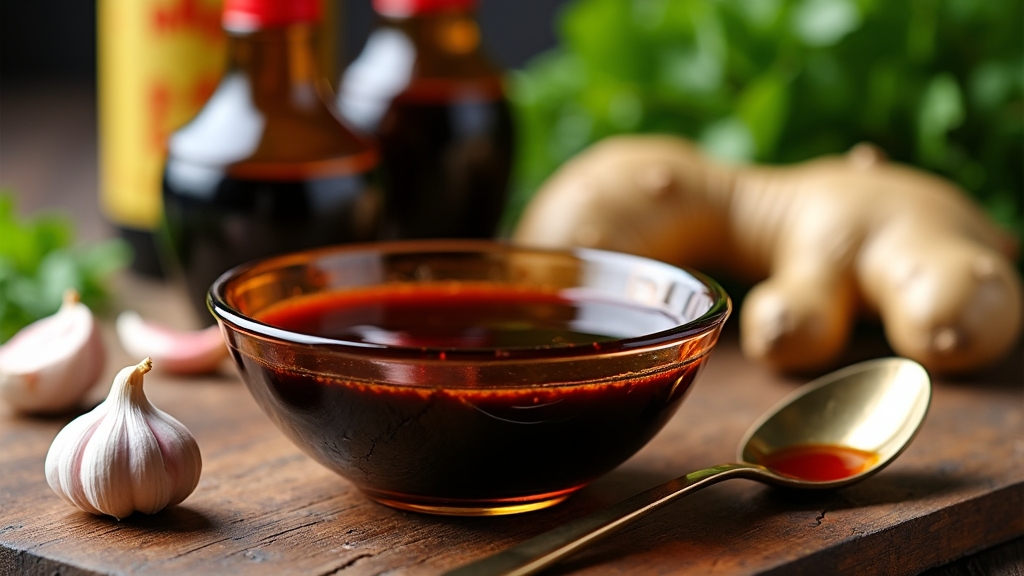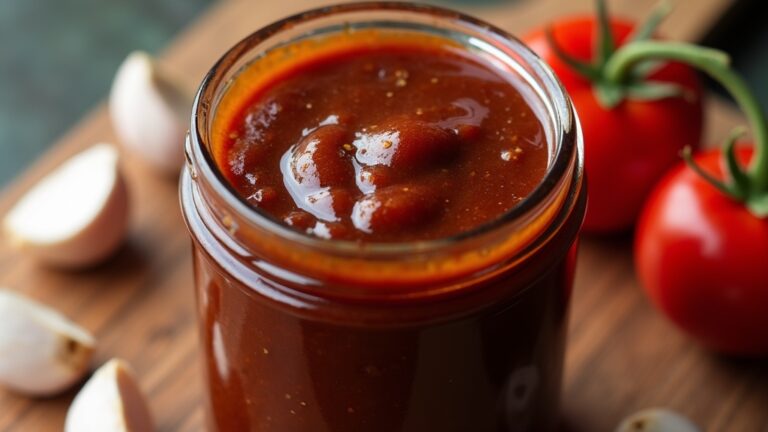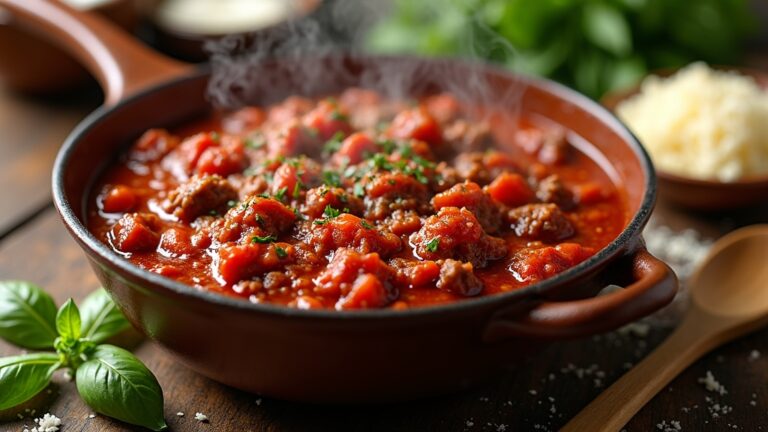Hoisin Sauce Recipe
I’m excited to share my homemade hoisin sauce recipe, blending sweet, tangy, and umami flavors. Just combine 4 tablespoons of soy sauce, 2 tablespoons of peanut butter, 1 tablespoon of honey or maple syrup, 2 teaspoons of rice vinegar, and a teaspoon each of sesame oil, garlic powder, and five-spice powder. Simmer it all for about five minutes, and you’ll have a versatile sauce perfect for stir-fries and marinades. If you’re intrigued, there’s more to explore!
Contents
History
When I plunge into the history of hoisin sauce, I’m always fascinated by its roots in Chinese cuisine. This rich, dark sauce, often misunderstood, has origins that intertwine with centuries of culinary traditions. It’s believed to have emerged from the Guangdong region, where flavors like sweet, salty, and umami meld seamlessly. The sauce’s flavor profiles are a symphony of fermented soybeans, garlic, and spices, making it a versatile companion in dishes ranging from stir-fries to marinades. As I explore its evolution, I can’t help but appreciate how hoisin sauce reflects the innovative spirit of Chinese cooking. Each drop captures the essence of a culture that thrives on balance and creativity, inviting us to adapt and experiment in our own kitchens.
Recipe
Hoisin sauce is a versatile and flavorful condiment popular in Chinese cuisine, known for its sweet, tangy, and slightly spicy notes. It is commonly used as a glaze for meats, a dipping sauce for spring rolls, and a key ingredient in various stir-fry dishes. Making your own hoisin sauce at home allows you to adjust the flavors to your liking and guarantees you have a fresh, preservative-free product at your fingertips.
Creating your own hoisin sauce is not only simple but also a rewarding experience. With just a handful of ingredients, you can whip up this delicious sauce in no time. Whether you’re looking to enhance your homemade dishes or impress your guests with a unique flavor, this recipe is sure to become a staple in your kitchen.
Ingredients:
- 4 tablespoons soy sauce
- 2 tablespoons peanut butter
- 1 tablespoon honey or maple syrup
- 2 teaspoons rice vinegar
- 1 teaspoon sesame oil
- 1 teaspoon garlic powder
- 1 teaspoon five-spice powder
- 1 teaspoon hot sauce (optional)
Cooking Instructions:
In a medium bowl, combine the soy sauce, peanut butter, honey (or maple syrup), rice vinegar, sesame oil, garlic powder, five-spice powder, and hot sauce (if using). Whisk together until the mixture is smooth and well-blended, making sure that there are no lumps from the peanut butter. Taste the sauce and adjust the sweetness or spiciness to your preference. Once satisfied with the flavor, transfer the sauce to an airtight container and refrigerate for at least 30 minutes to allow the flavors to meld.
Extra Tips:
For a thicker consistency, you can add more peanut butter or reduce the amount of soy sauce. If you don’t have five-spice powder on hand, you can create a substitute using equal parts ground star anise, cloves, cinnamon, Sichuan peppercorns, and ginger. Additionally, homemade hoisin sauce can last in the fridge for up to two weeks, so feel free to double the recipe to have more on hand for future meals. Enjoy experimenting with this sauce in various dishes to discover the best ways that suit your taste!
Cooking Steps
To whip up a delicious hoisin sauce, I start by gathering all my ingredients, ensuring I have everything at hand. Next, I combine the soy sauce and sugar, creating a sweet and savory base. Then, I add the hoisin and vinegar before letting the mixture simmer for five minutes, filling my kitchen with an enticing aroma.
Step 1. Gather All Ingredients
Gathering ingredients is like setting the stage for a culinary performance, and having everything ready makes the cooking process smooth and enjoyable. For my hoisin sauce, I start with the basics: soy sauce, sugar, rice vinegar, and sesame oil. But don’t hesitate to explore ingredient variations! Adding a touch of peanut butter or chili paste can elevate the flavor profile. You might also consider sauce substitutes like tamari for a gluten-free option or even coconut aminos for a sweeter touch. Organizing these ingredients beforehand not only sparks creativity but also guarantees I won’t miss anything essential during the cooking process. So, gather your ingredients, and let’s get ready to create something delicious!
Step 2. Combine Soy Sauce and Sugar
Start by measuring out a half cup of soy sauce and a quarter cup of sugar. The soy sauce brings a rich umami flavor, while its benefits include enhancing your dish’s depth and providing essential amino acids. If you’re looking for alternatives, consider these sugar substitutes:
- Honey – Adds a floral sweetness and a unique twist.
- Maple Syrup – Offers a subtle, earthy flavor that’s delightful.
- Agave Nectar – A low-glycemic option that’s sweeter than sugar.
- Coconut Sugar – Imparts a caramel-like taste, perfect for depth.
Once you have your soy sauce and sugar ready, combine them in a bowl. The mixture will become the backbone of your hoisin sauce, setting the stage for an incredible culinary experience!
Step 3. Add Hoisin and Vinegar
Next, I mix in a quarter cup of hoisin sauce along with a tablespoon of rice vinegar to enhance the flavor profile. As I pour in the hoisin, its rich, sweet aroma fills the air, promising a delightful depth to my sauce. The addition of rice vinegar is essential; it brings a tangy brightness that perfectly balances the hoisin flavor. This combination creates a symphony of tastes—sweet, savory, and tangy—that dances on the palate. I stir the mixture thoroughly, ensuring that every drop is infused with that harmonious vinegar balance. This step not only elevates the sauce but also sets the stage for a versatile condiment that can elevate countless dishes. Trust me; this is where the magic begins!
Step 4. Simmer Mixture for Five Minutes
With the mixture now perfectly balanced, I transfer it to a small saucepan and turn the heat to medium. This is where the magic happens as I employ a few simmer techniques to enhance flavor development. As the mixture begins to heat, I keep a close eye on it, stirring occasionally to prevent sticking. Here’s what I focus on during these five minutes:
- Consistent Temperature: Ensuring the heat is steady allows complex flavors to meld beautifully.
- Aroma Check: The delightful scent wafts up, signaling that the flavors are marrying.
- Texture Monitoring: I watch for the mixture to thicken slightly, indicating readiness.
- Taste Test: A quick taste reveals if further adjustments are needed before moving on.
Step 5. Stir in Garlic Paste
The simmering mixture has reached the perfect stage, and it’s time to add a burst of flavor with garlic paste. I scoop out a generous spoonful, letting it glide into the pot, where it melts into the warm concoction. The aroma is intoxicating, promising a delightful flavor enhancement that elevates my hoisin sauce to new heights. Garlic isn’t just about taste; its health benefits are a bonus. Rich in antioxidants, it’s known to boost immunity and promote heart health. As I stir, the paste transforms the sauce, infusing it with a savory depth that’ll elevate any dish. This simple step is essential, turning a basic sauce into a culinary masterpiece that’s both delicious and nutritious.
Nutritional Guide
While I savor the rich, sweet, and savory flavors of hoisin sauce, I also find it important to contemplate its nutritional profile. Understanding the ingredient breakdown helps me appreciate its nutritional benefits. This sauce is more than just a flavor enhancer; it contains a medley of ingredients that contribute to its unique taste and nutrient content.
| Ingredient | Nutritional Value (per tbsp) | Benefits |
|---|---|---|
| Soy Sauce | 11 calories | Low in fat |
| Sugar | 5 calories | Quick energy source |
| Garlic | 1 calorie | Boosts immunity |
| Vinegar | 0 calories | Aids digestion |
Incorporating hoisin sauce in moderation can elevate your dishes while providing some essential nutrients!
Final Thoughts
As I reflect on the versatility of hoisin sauce, I can’t help but appreciate how it can transform a simple dish into an extraordinary culinary experience. This sauce isn’t just a one-trick pony; it invites creativity in the kitchen. Here are some ideas for experimenting with sauce variations to elevate your meals:
- Mix with Sriracha for a spicy kick.
- Add to marinades for that sweet-savory flavor balancing.
- Use as a glaze for roasted meats or veggies.
- Incorporate into dressings for a unique dip.
Each application reveals a new dimension, showcasing hoisin’s ability to harmonize diverse ingredients. So, release your culinary imagination, and let hoisin sauce guide your journey to innovative dishes!
Frequently Asked Questions
Can I Substitute Ingredients in the Hoisin Sauce Recipe?
When I’m substituting ingredients, I often swap soy with tamari for a gluten-free option or use miso for a rich, vegan alternative. It’s a fun way to innovate and customize flavors in my dishes!
How Long Does Homemade Hoisin Sauce Last?
Picture a jar of rich, dark sauce glistening in the fridge. My homemade hoisin sauce lasts about a week in proper storage. For ideal sauce longevity, keep it tightly sealed, and enjoy its savory magic!
Is Hoisin Sauce Gluten-Free?
I’ve found that most traditional hoisin sauce isn’t gluten-free. However, several brands offer gluten-free alternatives. Always check the label to verify you’re enjoying a delicious, safe option without gluten hiding in the ingredients.
What Dishes Pair Well With Hoisin Sauce?
When I experiment, I love using hoisin sauce in stir fry combinations, enhancing veggies and proteins. It’s also a fantastic dipping sauce for spring rolls or grilled meats, adding a delightful, rich flavor that elevates every dish!
Where Can I Find Hoisin Sauce in Stores?
If you’re searching for hoisin sauce, I’ve found it at Asian grocery stores and International markets. They usually stock a wide variety, ensuring you’ll discover the perfect bottle to elevate your culinary creations.
Conclusion
In the end, making your own hoisin sauce is like opening a door to a world of flavor. With just a few simple ingredients, you can create a rich, sweet, and savory sauce that elevates any dish. It’s not just about the taste; it’s about the joy of crafting something unique in your kitchen. So go ahead, give this recipe a try, and let your culinary creativity flourish. You might just find that homemade is always better!







